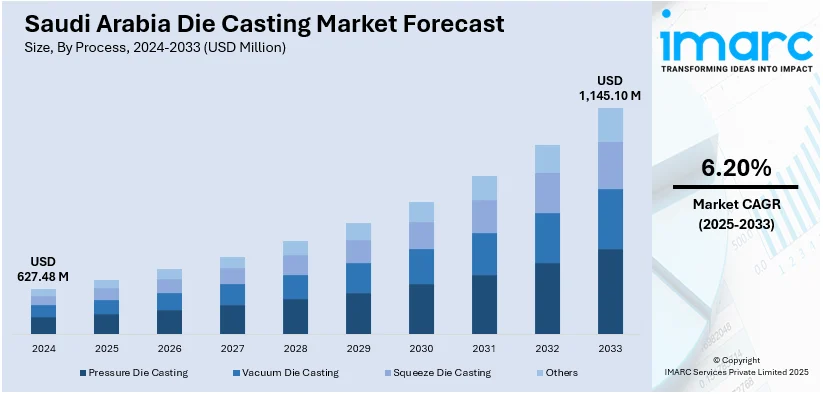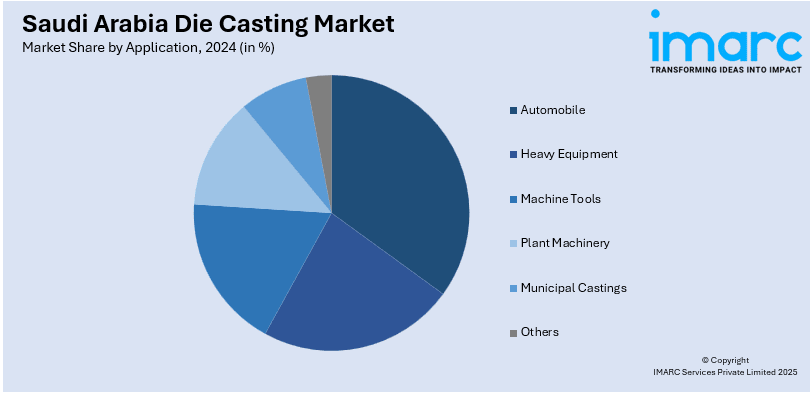
Saudi Arabia Die Casting Market Size, Share, Trends and Forecast by Process, Raw Material, Application, and Region, 2025-2033
Saudi Arabia Die Casting Market Overview:
The Saudi Arabia die casting market size reached USD 627.48 Million in 2024. Looking forward, IMARC Group expects the market to reach USD 1,145.10 Million by 2033, exhibiting a growth rate (CAGR) of 6.20% during 2025-2033. The market is driven by the increasing demand from the automotive, construction, and electronics industries, which are raising the need for quality, long-lasting metal parts. Advances in casting technology, including high-precision die casting and the utilization of lightweight materials, are also stimulating market growth. Also, the economic diversification efforts by the government and increasing manufacturing capabilities, as part of the Saudi Vision 2030 strategy, are further augmenting the Saudi Arabia die casting market share.
|
Report Attribute
|
Key Statistics
|
|---|---|
|
Base Year
|
2024
|
|
Forecast Years
|
2025-2033
|
|
Historical Years
|
2019-2024
|
| Market Size in 2024 | USD 627.48 Million |
| Market Forecast in 2033 | USD 1,145.10 Million |
| Market Growth Rate 2025-2033 | 6.20% |
Saudi Arabia Die Casting Market Trends:
Shift Towards Lightweight Materials and Energy Efficiency
The growing movement toward the utilization of light materials like aluminum and magnesium alloys, mainly due to the requirement for energy-efficient and high-performance parts, is positively impacting the market. Light materials lower the general weight of motor vehicles and machinery, which results in improved fuel efficiency, reduced emissions, and enhanced overall performance. The increasing use of electric vehicles (EVs) in Saudi Arabia also boosts this trend, as companies focus on minimizing battery weight and improving driving range. The trend towards magnesium alloys for die casting is also accelerating due to their superior strength-to-weight ratio, making them suitable for industries demanding strong but lightweight components. As per industry reports, the Kingdom has set an ambitious aim to reduce carbon emissions by 278 million metric tons per year (mtpa) by the year 2030 and to attain net-zero emissions by the year 2060. Therefore, there is an increased need for such materials as they coincide with the larger global trend toward sustainable manufacturing. These lightweight materials have advantages in recyclability as well as a lower environmental footprint. In addition to this, the continuous innovation in die casting methods to deal with such materials is imperative for responding to industry changes.

Increasing Demand from the Automotive and Aerospace Industry
The growing automotive and aerospace industries are significantly supporting the Saudi Arabia die casting market growth. These industries largely use die-cast parts to produce engines, transmission systems, body parts, and other fundamental components. The automotive sector is the major driver of demand for light, strong, and affordable materials. As per Saudi Arabia's Vision 2030, the nation has been emphasizing the diversification of its economy and the strengthening of its manufacturing base. The country plans to manufacture half a million cars annually by the year 2030. With growing local production capacity and foreign investments, the need for high-quality die-cast components for domestic consumption and exports will continue to grow. The aerospace industry demands die casting for important components like engine components, landing gears, and structural parts, further fueling market demand. Moreover, with the adoption of electric vehicles (EVs) by Saudi Arabia's automotive industry, the demand for sophisticated die-cast parts that are certified to the exacting standards of these vehicles is on the rise. These factors are facilitating the market development in the country.
Saudi Arabia Die Casting Market Segmentation:
IMARC Group provides an analysis of the key trends in each segment of the market, along with forecasts at the country and regional levels for 2025-2033. Our report has categorized the market based on process, raw material, and application.
Process Insights:
- Pressure Die Casting
- Vacuum Die Casting
- Squeeze Die Casting
- Others
The report has provided a detailed breakup and analysis of the market based on the process. This includes pressure die casting, vacuum die casting, squeeze die casting, and others.
Raw Material Insights:
- Aluminum
- Magnesium
- Zinc
A detailed breakup and analysis of the market based on the raw material have also been provided in the report. This includes aluminum, magnesium, and zinc.
Application Insights:

- Automobile:
- Body Parts
- Engine Parts
- Transmission Parts
- Others
- Heavy Equipment:
- Construction
- Farming
- Mining
- Machine Tools
- Plant Machinery:
- Chemical Plants
- Petroleum Plants
- Thermal Plants
- Paper
- Textile
- Others
- Municipal Castings:
- Valves and Fittings and Pipes
- Others
The report has provided a detailed breakup and analysis of the market based on the application. This includes automobile (body parts, engine parts, transmission parts, and others), heavy equipment (construction, farming, and mining), machine tools, plant machinery (chemical plants, petroleum plants, thermal plants, paper, textile, and others), municipal castings (valves and fittings and pipes), and others.
Regional Insights:
- Northern and Central Region
- Western Region
- Eastern Region
- Southern Region
The report has also provided a comprehensive analysis of all the major regional markets, which include Northern and Central Region, Western Region, Eastern Region, and Southern Region.
Competitive Landscape:
The market research report has also provided a comprehensive analysis of the competitive landscape. Competitive analysis such as market structure, key player positioning, top winning strategies, competitive dashboard, and company evaluation quadrant has been covered in the report. Also, detailed profiles of all major companies have been provided.
Saudi Arabia Die Casting Market News:
- On Feburary 3, 2025, Obeikan Glass Co. commenced trial operations at its new aluminum casting facility, the Saudi Aluminum Casting Foundry, located in Al-Madina Al-Munawwara Industrial City. Established through a SAR 73 million (about USD 19.47 Million) partnership with Al-Esra Aluminum Factory, the foundry aims to produce a range of aluminum products, with commercial operations anticipated in the first quarter of 2025. This initiative aligns with Saudi Arabia's strategic efforts to enhance its domestic manufacturing capabilities.
Saudi Arabia Die Casting Market Report Coverage:
| Report Features | Details |
|---|---|
| Base Year of the Analysis | 2024 |
| Historical Period | 2019-2024 |
| Forecast Period | 2025-2033 |
| Units | Million USD |
| Scope of the Report |
Exploration of Historical Trends and Market Outlook, Industry Catalysts and Challenges, Segment-Wise Historical and Future Market Assessment:
|
| Processes Covered | Pressure Die Casting, Vacuum Die Casting, Squeeze Die Casting, Others |
| Raw Materials Covered | Aluminum, Magnesium, Zinc |
| Applications Covered |
|
| Regions Covered | Northern and Central Region, Western Region, Eastern Region, Southern Region |
| Customization Scope | 10% Free Customization |
| Post-Sale Analyst Support | 10-12 Weeks |
| Delivery Format | PDF and Excel through Email (We can also provide the editable version of the report in PPT/Word format on special request) |
Key Questions Answered in This Report:
- How has the Saudi Arabia die casting market performed so far and how will it perform in the coming years?
- What is the breakup of the Saudi Arabia die casting market on the basis of process?
- What is the breakup of the Saudi Arabia die casting market on the basis of raw material?
- What is the breakup of the Saudi Arabia die casting market on the basis of application?
- What is the breakup of the Saudi Arabia die casting market on the basis of region?
- What are the various stages in the value chain of the Saudi Arabia die casting market?
- What are the key driving factors and challenges in the Saudi Arabia die casting market?
- What is the structure of the Saudi Arabia die casting market and who are the key players?
- What is the degree of competition in the Saudi Arabia die casting market?
Key Benefits for Stakeholders:
- IMARC’s industry report offers a comprehensive quantitative analysis of various market segments, historical and current market trends, market forecasts, and dynamics of the Saudi Arabia die casting market from 2019-2033.
- The research report provides the latest information on the market drivers, challenges, and opportunities in the Saudi Arabia die casting market.
- Porter's five forces analysis assist stakeholders in assessing the impact of new entrants, competitive rivalry, supplier power, buyer power, and the threat of substitution. It helps stakeholders to analyze the level of competition within the Saudi Arabia die casting industry and its attractiveness.
- Competitive landscape allows stakeholders to understand their competitive environment and provides an insight into the current positions of key players in the market.
Need more help?
- Speak to our experienced analysts for insights on the current market scenarios.
- Include additional segments and countries to customize the report as per your requirement.
- Gain an unparalleled competitive advantage in your domain by understanding how to utilize the report and positively impacting your operations and revenue.
- For further assistance, please connect with our analysts.
 Request Customization
Request Customization
 Speak to an Analyst
Speak to an Analyst
 Request Brochure
Request Brochure
 Inquire Before Buying
Inquire Before Buying




.webp)




.webp)












